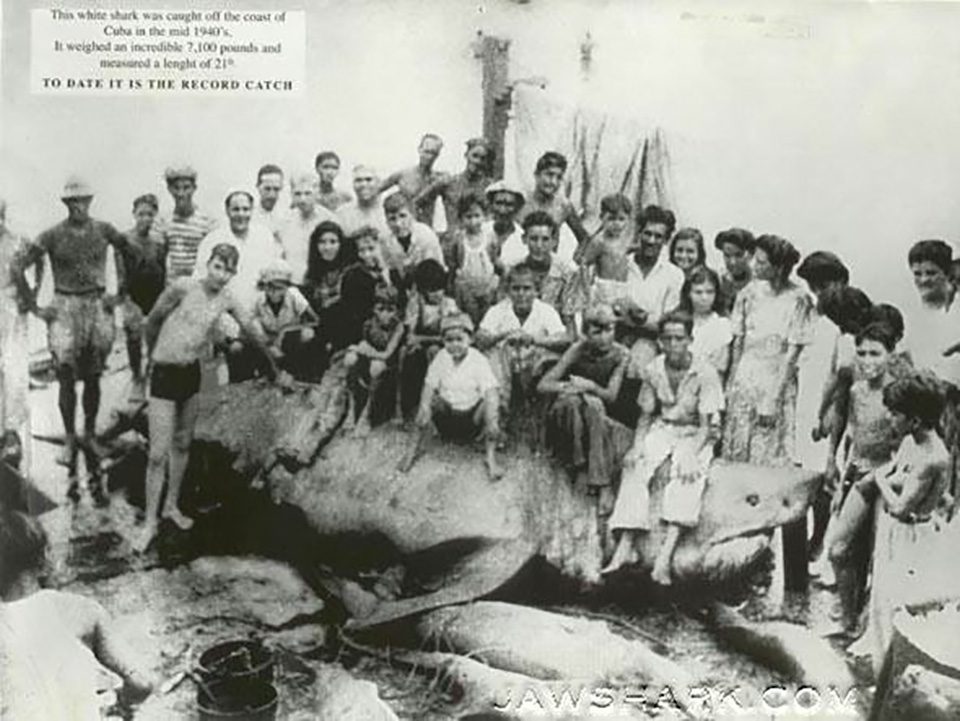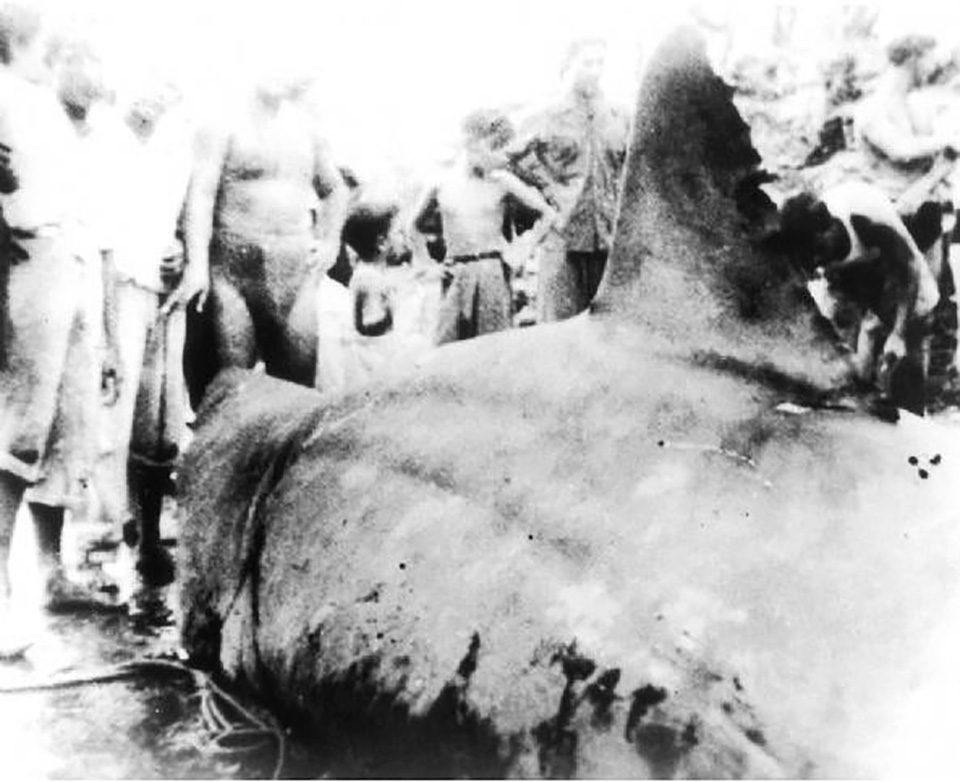
By The Mad Deckhand
A friend of my father was one of six fishermen who participated in the hunt. My father tells the story and it feels that I’m reliving a scene from the movie “Jaws.” As my father tells the story, it was a calm June day when six fishermen of Cojimar sailed out to sea in their 14-foot wooden skiff to fish for tuna, sharks, dorado and other species. It was their daily livelihood.
That day, although it was a typical day in June, there was an eerie feeling among the fishermen. Before sunrise, the fishermen already had sailed about three miles, just to the edge of the Gulf Stream, where the current is strong enough for large pelagic fish to abound. One of the fishermen put bait in the water, as he did every morning. Ballyhoo is the blue marlin’s favorite bait. That particular day the fishermen wished for a large blue marlin, it was considered one of the best paid fish.
After a couple of hours, not a single fish had shown interest in the fresh ballyhoos that were lying motionless in the water. Other boats that were not too far away seemed to have the same luck. Old salts talk about luck all the time. Usually, one can see the splash of a fish that is being caught by another boat. Sometimes you can even hear fishermen in other boats when a fish is caught. But that day, all was calm. At exactly 9 a.m. a large shark fin appeared only a few feet way from the skiff. Although the fishermen were experienced shark fishermen, they were surprised and left speechless by the size of the fin cutting through the water. One of the fishermen exclaimed out loud “No wonder there are no fish around!” They knew it was a great white shark.
In great excitement, the fishermen tossed bait and chum in the water to keep the shark near. This shark was bigger than all other sharks that they had ever seen or caught. Immediately, they tied several lines together. For bait they used half of a tuna that was bitten by a smaller shark while fishing the day before.
The smell of bait and chum in the water brought the shark closer to the skiff, it passed parallel to the boat and the men saw that it was much bigger than their boat. They looked at each other with uncertainty and disbelief. It was perhaps a moment of fear, however catching this shark would make the pay for many days at sea. There was no time to waste. They hooked the half tuna in a shark hook that was followed by a wire leader and by thousands of feet of old silk rope. One of the men gently tossed the bait in the deep blue water. The shark passed the boat again and swallowed the bait whole.
The shark began taking line almost immediately but the men knew that no human hands could stop such a fish. They had palangres with them, these are small wood rafts used to lay many lines in the water from one raft to the other. The palangres were used for swordfish fishing at night. The fishermen knew that the palangres would increase the resistance to the hooked shark.
After many hours of following the palangres that were being pulled by the shark, the line began to surface. They knew then that the fish was tired of pulling the extra weight. One of the fishermen recovered line while others prepared a harpoon. They knew that the most dangerous moment lay ahead, as the shark got closer to the boat.
After more than one hour of recovering line, they saw the shark 60 to 80 feet under the skiff — even then, it looked big. The moment of truth was approaching. The fishermen could feel their own hearts beating rapidly. They were hoping that the shark was really tired or near death, but they did not imagine that their worst nightmare was approaching the boat.
When the shark was only 20 feet from the boat, it torpedoed directly to the keel and struck the boat sideways.Then it turned back and began biting the keel of the boat. One of the fishermen saw pieces of wood floating next to the boat. He described it as thousands of toothpicks floating next to the skiff. They knew that there was plenty of life left in the fish, so in a hurry they prepared the harpoon — a hand-held wooden pole with a sharp bronze tip — and without hesitation they harpooned the shark in its next attack to the boat.
The harpooned shark calmed down but not enough. The fish continued biting the keel of the boat and at one time it took pieces of the rudder. This fish put up a great fight before being caught, perhaps one of many fights in its long life. These fishermen respected the ocean and the creatures in it. They spoke highly about this particular shark and the fight it put on. Perhaps they were sorry that they had to kill such a great fish — but they were fishermen by circumstances and not by choice.
A notes from the author:
The shark never made it to the International Game and Fishing Association records. Communication in 1945 was not as advanced as today. Although, many great white sharks claim records, this shark by far supersedes all statistics from all other great white sharks recorded. The estimated weight of this shark was 7,000 pounds and its length 21 feet. Its liver weighed approximately 1,500 pounds. The pictures were taken by a reporter from the French newspaper “Le’ Monde.” The reporter was vacationing in Havana and used his field camera. The photos were later taken out of Cuba by one of our family members. These photos will make shark experts rewrite the history of the largest great white shark ever caught.
Today, most experts contend that the great white’s “normal” maximum size is about 6 metres (20 ft), with a maximum weight of about 1,900 kilograms (4,200 lb). Any claims much beyond these limits are generally regarded as doubtful, and are closely scrutinized.
For some decades many ichthyological works, as well as the Guinness Book of World Records, listed three great whites as the largest individuals caught : an 11 metre (36 ft) great white captured in south Australian waters near Port Fairy in the 1870s, an 11.3 metre (37.6 ft) shark trapped in a herring wier in New Brunswick, Canada in the 1930s and the record holder a 41.2 ft monster caught west coast of the Azores Islands by a Portugese fishing trawler. While this was the commonly accepted maximum size, reports of 7.5 to 10 metre (25 to 33.3 ft) great whites were common and often deemed credible.
Some researchers questioned the reliability of those measurements in the Guiness Book, noting they were much larger than any other accurately-reported great white. The New Brunswick shark may have been a wrongly-identified basking shark, as both sharks have similar body shapes. The question of the Port Fairy shark was settled in the 1970s, when J.E. Reynolds examined the shark’s jaws and “found that the Port Fairy shark was of the order of 5 m (17 feet) in length and suggested that a mistake had been made in the original record, in 1870, of the shark’s length. As for the Azores record holder, that listing has quietly been removed from the book since it’s appearance in Guiness volumes in the late 1970’s and early 1980’s.
It turns out that there are more “fish stories” than actual “monster sharks.”
Everyone has heard of a giant shark… most end up being hogwash.
